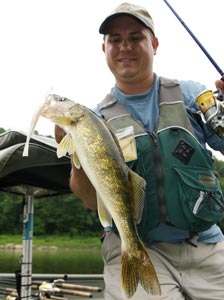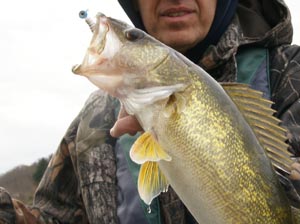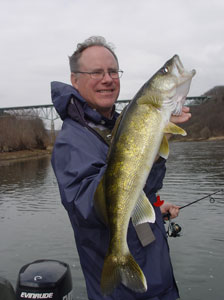
 |
| Soft jerkbaits are ideal for targeting tail-out river sections. |
It's no secret that walleyes become a prime target in many river systems come fall. But much of what's been written on the subject is about larger rivers, navigable waters featuring dam systems that provide specific barriers that collect fish below them. However, walleyes exist in smaller rivers, free-flowing waters where fish relate to the natural habitat found there. And many anglers are missing out on the great fall fishing these rivers provide.
Free-flowing rivers that support walleye populations tend to have a fairly low gradient. Long, deeper pools are linked together with sections of fast water riffles, as well as "runs" that feature moderate current and depth. Like walleyes that live in impounded rivers, ones hosted by natural rivers make seasonal movements as water temperatures drop during the fall. Walleyes in the big rivers will move from mid-river channels to slackwater areas found near tailraces, wingdams and incoming tributaries; similarly fish in smaller, free-flowing rivers look to the slow-current living conditions provided by deep holes, pools downriver of islands, and areas protected by sand/gravel/rock bars.
Basically, this movement is from faster, current-laced areas early in the fall, to the protected slackwater spots late in the fall, where the fish will likely spend the winter. Locating and catching walleyes throughout the autumn transition requires keying in on the types of water they use during the current conditions, and also showing them a presentation appropriate for that situation.
Early Fall Walleye Fishing
During the early portion of the fall – when water temperatures range from the low 70s down around 60 degrees – free-flowing river walleyes will still be in the type of water that attracted them over the summer months. This includes areas fed by heavy current riffles. The turbulence that occurs in riffle areas oxygenates the water; this environment attracts baitfish, which in turn draws in foraging walleyes.
The more productive riffle areas tend to have feeding lies, places where walleyes can escape the hard current, but can quickly rocket out from the cover to intercept a baitfish. Such places can take the form of side eddies next to the fast water, as well as midstream subsurface rocks.
Walleyes holding close to fast water are there to eat; they'll respond best to a fairly fast moving bait that mimics that they're feeding on. This includes hard jerkbaits like the Lucky Craft Pointer in sizes 78 and 100, the XCalibur Xs4 Stickbait and Xt3 Twitchbait, and Rapala's Husky Jerk in 3 1/8- and 4-inch models. Though these baits are designed to be fished in a jerk-pause cadence, walleyes often prefer a steadier retrieve. This isn't to say you can't pause a jerkbait when targeting walleyes, just that erratic retrieves that work on bass typically aren't the best approach for 'eyes. You'll take more by toning down the retrieve.
Another excellent early fall walleye lure is a soft swimbait. Pre-rigged soft swimmers like Storms WildEye Pro Paddle Tail or Northland Tackle's Slurpies Swim Shiner excel in this situation.
With both the hard jerkbait and soft swimbait, the best approach is to simply allow the boat to drift down through the fast water, and then make cross-current casts perpendicular to the boat. Wade fishermen can target the same types of spots by getting into position below a riffle area and then making casts that quarter upstream.
Mid-Fall Walleye Fishing
 |
| A leadhead jig dressed with a twister-tail soft body is a good combination for late-season fall walleyes. |
As water temperatures drop into the 60s and continue their downward movement into the 50s, river walleyes will vacate the heavy current areas.
One of the better mid-fall spots is the tail-out section of a larger pool. The tail-out is the area where a deeper pool shallows-up before it breaks into the next riffle. Since a large volume of water is being funneled through this shallower area the current picks up, but is generally not so strong as to preclude walleyes' presence there, at least during times of normal flows.
Some tail-outs are fairly short, as the pool quickly lifts up and dumps into the riffle; in others the transition is more gradual, sometimes stretching out for a couple hundred yards. The presence of cover such as rocks and submerged weeds (typically eelgrass/water celery) increases the chances walleyes will use the area. Also, tail-outs are included to be more fruitful during twilight periods, and during cloudy/rainy days.
The tail-out sections walleye use are fairly shallow, in the 2- to 4-foot range. Though typically considered a bass bait, one of the better offerings for this situation is a soft jerkbait like Zoom's Super Fluke or Yum Houdini Shad. These soft stickbaits are ideal for working over top the bent-over (from the current) weedbeds typically found in such areas.
When working tail-outs, I like to retard the boat's drift with the electric motor. I then make cross-current casts, working the bait back with a subtle perk-pause cadence. The bait will swing with the current during the first part of the retrieve, eventually straightening out directly downriver from the boat, where the swing will stop. Many times a walleye will hit right at the end of the swing.
Late Fall Walleye Fishing
The dip of water temperatures into the upper 40s signifies the arrival of late fall, a period that will continue right up until freeze-up.
By this time walleyes (along with pretty much all river-dwelling fish) will be congregated in slackwater holes located out of the main force of the river's current. Make note, higher water flows during the fall will hasten walleyes' migration to these protected areas.
 |
| Though the rivers they come from are smaller, expect to catch quality-sized walleyes during the fall. |
Slackwater holes are often located on major river bends, where the current gouges out deep depressions. Major islands also deflect current; areas downriver of an island often hold walleyes if there's a decent amount of depth. Gravel bars are often washed out in a river at the mouth of feeder streams. These obstructions nearly always have good walleye-holding water below them (and in some cases upriver of them as well). A good way of finding slackwater pools and eddies during the fall is to observe the areas that collect leave litter and other floating debris.
Throughout the day walleyes will mill around these protected areas. Leadhead jigs, like Bass Pro Shops Walley Jig, dressed with a soft twister tail body, or tipped with a medium-sized fathead minnow, excel at catching these fish (which are typically in a neutral to negative mood). Simply allow the boat to slowly drift down the pool while yo-yoing the jig in a vertically manner (right under the boat). As the boat drifts over depth changes make the necessary adjustments by taking in or letting out line. The idea is to hover the jig a few inches off the bottom, occasionally dropping it the whole way to the bottom to help trigger a bite (and to confirm that the jig's location is just off the bottom).
Quarter-ounce jigs are nearly always the right size for the depth fished in free-flowing river pools (8-15 feet). Color-wise, orange is a good dirty water color. Chartreuse, lime green and firetiger are good stained water colors. White often excels in clear water. Experiment throughout the day, though, as walleyes can be finicky, color-wise, at this time of year.
Cold water river walleyes are apt to be more active during cloudy/rainy days, and during the evening twilight period. At these times they'll often be in shallower water. One of the key areas they'll invade at such times is the mouth of a feeder stream. In this case it's wise to anchor the boat near the creek mouth and cast to the fish. It might take a couple tries to get the boat in just the right position to proper work the spot, but the effort is often worth it. Dropping down to a 1/8 or 3/16 ounce jig can also be fitting for this circumstance.
- 18093 views

